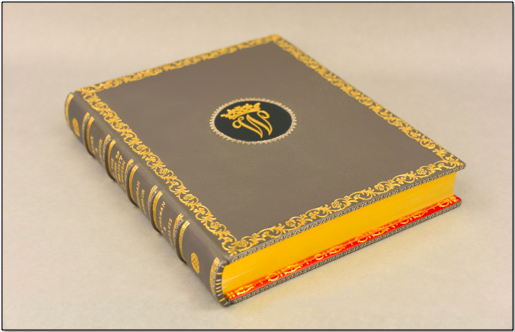As part of the BPG specialty sessions at the 47th annual AIC meeting, Philippa Räder introduced us to the Queen’s Bindery Apprenticeship scheme for the preservation of traditional bookbinding and conservation skills in the UK. The apprenticeship, which is hosted at Windsor Castle, accepts two students annually to undertake the two to five year training program. As Head of the Royal Bindery, Philippa is responsible for overseeing the students. The first graduating pair are due to complete the program in 2021.
The intention of the program is to preserve traditional skills such as bookbinding, gold tooling, and edge decoration, which may otherwise be lost. It is also intended to provide students an alternative to formal education through craft-based learning that acknowledges the importance of these skills within fields such as conservation.

A view of Windsor Castle, where students from the Queen’s Bindery Apprenticeship Scheme work.
The program takes a holistic approach to teaching, with the intention of producing ready-to-work craftsmen and women who possess all the skills required for successful employment in the world of binding and/or conservation. This begins with a rigorous application process where hopefuls are assessed on their hand skills and ability to follow directions (including showing up wearing closed toed shoes rather than flip-flops). If accepted, course work includes lessons on business skills such as basic book-keeping and shop inventory. Skills many conservators must learn on the fly, such as pricing work, avoiding waste, and estimating the time a treatment will require are also covered.

Set up for the practical tests required of applicants
Practical work focuses on traditional craft skills as a vehicle for informing a wider practice of fine bindings and conservation/restoration. Beginning with the basics, students make single section pamphlets and cloth case journals before quickly moving into leather case bound books stamped with gold foil lettering. The second year focuses on fine leather binding, gold tooling, doublures, and sewing end bands. At this point students are capable of working for a commercial bindery in the UK or starting a business of their own, however, they also have the option to continue in the program to focus on high-level skills.
Years three, four, and five introduce conservation and restoration skills using the previously gained binding practice as a basis. Housing for collection items, including clamshell and other archival boxes, are made and historical binding structures are covered so students are aware of appropriate styles if rebinding is deemed appropriate. Finally, gold finishing and book design are a focus before completion.

Beautiful fine binding created by the binders-in-training
Historically, England has a strong precedent for apprenticeship education, including the 1563 Statute of Artificers, which required by law that seven years is the minimum time for training before a craftsman can ply their trade.
Despite this, the UK has seen a steep decline in apprenticeship-based education since the 1970s, and before the Queen’s Bindery Scheme, had no formal apprenticeships in bookbinding were still in existence. A shift towards academic training had the consequence of devaluing high-level technical skills and led to the demise of formal apprenticeship-based education. To remedy this shift and preserve skills which otherwise may be lost, the Royal Collection Trust has partnered with the UK government, and charity organizations such as the Worshipful Company of Stationers to develop a program that provides practical, skills-based learning following the paid apprenticeship model. Although the program has earned a high level of success (including interest from the Queen herself!) Philippa shared some insight into the steep requirements necessary to implement it.

The queen scrutinizes work done by the Windsor bindery at the launch celebration for the program
It was refreshing to hear that alternative models for craft education are being implemented. Nothing of this sort exists in the US (as far as I know), however, given the current state of conservation training, funding alternative paths into the profession would serve to greatly improve skill sets and diversity within the field.
There was certainly much to be gleaned from this discussion and we are thankful for Philippa for sharing her experiences.
#AICmtg19
#47thAnnualMeeting(NewEngland)#Featured